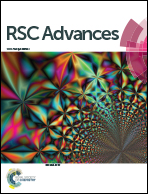An efficient catalyst free synthesis of nitrogen containing spiro heterocycles via [5 + 1] double Michael addition reaction†
Abstract
2,4-Diazaspiro[5.5]undecane-1,3,5,9-tetraones and 3-thioxo-2,4-diazaspiro[5.5]undecane-1,5,9-triones have been synthesized via double Michael addition of 1,5-diaryl-1,4-pentadien-3-one with active methylene compounds such as N,N-dimethyl barbituric acid, barbituric acid, thio-barbituric acid and N,N-diphenyl thiobarbituric acid in ethylene glycol at 100 °C in the absence of any catalyst to give high yields within a short reaction time. The structure has been confirmed by X-ray analysis. The single-crystal structure of the diazaspiro compound revealed that the CAr–H⋯π, π–π stacking and intermolecular hydrogen bonding interactions act as major driving forces for crystal packing.
![Graphical abstract: An efficient catalyst free synthesis of nitrogen containing spiro heterocycles via [5 + 1] double Michael addition reaction](/en/Image/Get?imageInfo.ImageType=GA&imageInfo.ImageIdentifier.ManuscriptID=C4RA00521J&imageInfo.ImageIdentifier.Year=2014)

 Please wait while we load your content...
Please wait while we load your content...